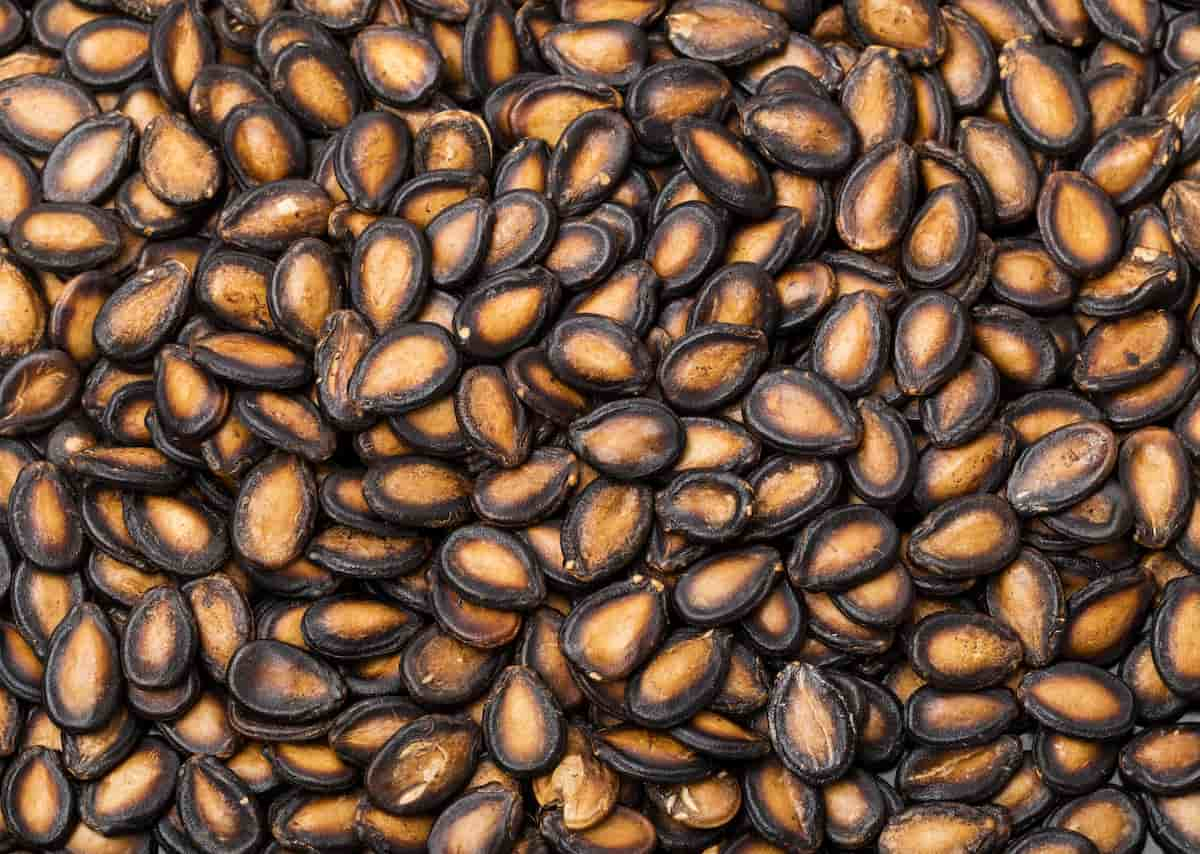Black watermelons are known for their enormous size and sweet, juicy flesh. Many large commercial farms and home gardens grow this heirloom variety. Red flesh can be found in the dark, blue-green-black melons. There are usually no stripes on watermelon varieties that are more familiar. Producing mature fruit for melons, which can weigh up to 50 pounds, requires a long growing season.

It can take around 90 days for these large, sweet melons to mature, so give them plenty of sunshine and water to keep them healthy and strong. When allowed to trail along the ground, these vines can grow up to 20 feet long. Due to the fruit’s heavy weight, trellising is not recommended. As watermelons ripen, you can keep them dry by placing them on wood or cardboard to discourage rot and soft spots.
Black Watermelon Farming
Spacing Requirements for Growing Black Watermelon
The vines of black watermelon grow from fifteen to twenty feet long, so they need to be spaced properly. Twenty-inch melons can also have a diameter of six feet and a length of twenty inches. Therefore, you should space your seeds four to six feet apart. If you want to grow them vertically, you’ll need trellis supports.
How to Plant and Grow Black Watermelon
- Ideally, you should test your soil’s pH two months before the last frost. It is recommended that the soil pH is between 6.5 and 7.5. Limestone can be added to raise the soil pH, while sulfur can be added to lower it. Retest the soil before planting.
- When the soil reaches 21°C, about one or two weeks after the last frost, till it loosens and aerates, then add 9 inches of manure or organic compost.
- Plant the seeds with a hoe in hills or mounds a few inches high, about 4 to 6 feet apart. Approximately 1-inch deep holes should be dug in each mound, and each hole should be planted with a seed. Put a light layer of soil over the seeds and pat them down.
- Keep the seeds moist by watering them. Plants should be cut down to soil level once they reach about 4 inches high and have true leaves. Keep two or three of the strongest plants and cut the rest to the soil level.
- Maintain a warm and moist environment for the seedlings by covering the soil with mulch. The presence of mulch also prevents weeds from growing excessively.
- Once the plants have flowered in the spring, fertilize them with African violet fertilizer or liquid seaweed fertilizer.
- The soil should be watered deeply as often as necessary to keep it moist but not soaking wet. You should avoid wetting the foliage or fruit. As soon as the fruits reach the size of a tennis ball, reduce watering to every few days or when the soil dries out.
- Aphids and cucumber beetles may be found on plants and leaf undersides. Spray foliage thoroughly with insecticidal soap if you notice aphids. Cucumber beetles can be controlled with rotenone or pyrethrum-based insecticides sprayed at dusk. The process should be repeated weekly until the pests have disappeared.
- Keep watermelons dry while they grow by placing them on wood, straw, or cardboard. After the melons have developed a pale yellow spot on their bottom side, you can cut them from the vine. It can take up to 90 days for this to happen.
Light and Soil Requirements for Growing Black Watermelon
Sunlight is essential for black watermelon, as it is for all melons. To keep these plants growing strong, they need at least six to eight hours of sunlight daily. Organic material is important for the growth of black watermelons. They prefer warm, moist, well-draining, neutral soil to slightly acidic. By mulching the soil beneath the vines and fruits with organic material, such as straw, you will help keep the soil moist.
In case you missed it: A Step-by-Step Guide for Growing Watercress Microgreens: DIY in Simple Way from Seeds in Containers

Watering Requirements for Growing Black Watermelon
Juicy fruits like watermelons need consistent watering, so it’s no wonder they need regular irrigation. Ensure the soil should be moist but not soggy. Watering these plants regularly will keep them healthy. Avoid getting the vines’ leaves wet, which can cause fungal problems. Water the vines where they are rooted in the soil. Melons should only be watered when the soil begins to dry out once they reach the size of a tennis ball. Stop watering it two weeks before the fruit ripens to increase its sugar content.
Fertilizer Requirements for Growing Black Watermelon
Black watermelons thrive in rich soil and organic matter. Ensure these melons get the necessary nutrients by composting the soil before planting. The application of fertilizer can encourage healthy fruit production once flowers appear. When a plant starts to grow, it is best to fertilize it with nitrogen-based fertilizer, then switch to phosphorus- and potassium-based fertilizers.
Mix 4 to 6 cups of 10-10-10 fertilizer per 100 square feet in the soil where the seeds or sprouts will be planted to fertilize a watermelon. After the plant has grown vines with runners, it will need to be fertilized again. Watermelon mounds should now be fertilized with 20-0-0 fertilizer in 1 to 2 tablespoons.
Mulching and Pruning Black Watermelon Vines
Adding mulch around the plants will serve multiple purposes: warming the soil, preventing weeds’ growth, and preventing weed seed development. Pruning watermelon plants isn’t necessary, but you can increase vine productivity by preventing lateral (side) vines from growing and sticking to the main vine. When the plant is young, remove the end buds as they form (before the side shoots become vines). You can also cut off some blossoms to direct more energy toward fewer melons (though this is difficult).
Harvesting Black Watermelons
When it comes to watermelon, determining when fruits are at peak ripeness can be a bit challenging. Picking a ripe watermelon involves paying close attention to the tendril that connects the melon to the plant stem. When the tendril on the melon is still green, the melon is still unripe. On the other hand, the melon is ripe or is just beginning to ripen if the tendril is dried and brown. The following tips are to tell when watermelons are ripe:
- Thump on it. Watermelon that sounds hollow is ripe.
- ·Press it. Ripe watermelon sounds like it gives a little when you tap it.
- Tendrils should be checked. Wait if it’s green. The watermelon is approximately ripe or ripe if it’s half-dead. If the tendril is dead, it’s ripe or overripe; ripening won’t occur, so pick it up while it’s ripe.
- A sharp knife should be used to cut the stems close to the fruit.
In case you missed it: How to Grow Apples Organically: A Step-By-Step Guide for Beginners

Conclusion
If you are thinking about growing black diamond watermelon, note that this heirloom variety, which features a tough, blue-green rind and red flesh, requires plenty of space because the fruits typically weigh around 50 pounds and sometimes even more. Like all watermelons, the Black Diamond is grown as an annual. Providing plenty of organic matter to feed the plant throughout the season can help you grow large, sweet watermelons.
- Feed Your Flock for Less: Top 10 Tips to Save on Chicken Feed
- Ultimate Guide to Ossabaw Island Hog: Breeding, Raising, Diet, and Care
- Hatching Answers: The Top 10 Reasons Your Chickens Aren’t Laying Eggs
- Eggs and Economics: Breaking Down the Cost of Raising Backyard Chickens
- Defend Your Greens: Proven Methods to Keep Iguanas Out of Your Garden
- Ultimate Guide to Cinnamon Queen Chicken: A Comprehensive Guide for Beginners
- Ultimate Guide to California Tan Chicken: Breeding, Raising, Diet, Egg-Production and Care
- Ultimate Guide to Marsh Daisy Chicken: Breeding, Raising, Diet, and Care
- 10 Types of Chicken Farming Businesses You Can Start for Profits